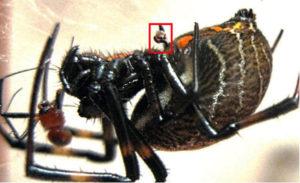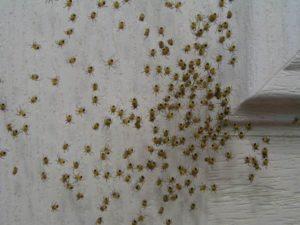Spider eggs: photos of animal development stages
A wide variety of spiders is represented by various sizes of insects that differ in appearance. They are quite tiny, the size of a pea, and there are those who will take up a full palm. But few people have seen spider babies, this is due to the reproduction of spiders.
Content
spider sex organs
Spiders are heterosexual animals. Females and males differ from each other in appearance, size and structure. The difference is in the jaw tentacles. Males have a pear-shaped appendage on the last segment of the tentacle, which stores seminal fluid. That, in turn, is produced in a special genital opening in front of the lower abdomen. In the process of intercourse, the spider transfers its seed to the female in the seed receptacle.
There are eunuch spiders that, as a result of intercourse, leave their organ in the female. But he has a pair, and if he manages to escape, he can fertilize the second one. When, as a result of intercourse, he loses the second sexual organ, he becomes the guardian of the female.
Spider mating
Spiders usually mate in late summer. After fertilization, development occurs.
Male actions
Before proceeding to mating, the male still needs to approach his lady. Much depends on the type of spider, but there is a general rule - a courtship dance before the act begins. It can go like this:
- the male climbs into the web to the female and makes different movements to attract her;
- the male moves near the mink of the chosen woman in order to lure her out, inactive;
- the male is trying to break the web, which the lady is carefully preparing for herself, in order to repel other potential suitors and lure the lady out.
After mating, the male may or becomes the female's dinner if he does not have time to escape. But there are species of animals in which a man nurses offspring.
Actions of the female
Spider women are more active. From the very spring they prepare their dwelling. Whether it's a cobweb on a tree, on the surface of the ground or mink, they equip comfortable places.
Closer to autumn, they equip a white-yellow cocoon of cobwebs, in which the testicles will be laid. The place for the cocoon is chosen secluded.
Spider growing up
The spider embryo has a large number of segments, laid in an egg along with the yolk, which the newborn will eat. The embryo at first resembles a larva, when it grows it breaks the egg shell.
A small spider until the first molt is in the rest of the egg. He is still completely whitish and naked, but already looks like an adult.
The animal changes its soft chitinous skin to a hard one.
Depending on the species, these spiderlings either live in the shell or actively leave the nest.
Further development
Among spiders, most species are caring mothers. There are those that feed offspring themselves, there are individuals that even die themselves and sacrifice their bodies for the sake of offspring. But they also have cannibalism, when the stronger ones devour the younger individuals.
Species Features
The life of spiders at the stage of growing up depends on their species.
- The crosses remain in the sunny meadow with the whole society for a long time.
- Tarantulas travel around the habitat on the back of their mother, fall from there themselves or through her efforts.
- Wolves on the belly of the spider hold on, but not for long. They cling to anything, including cobwebs.
- Side walkers begin to jump as soon as their legs get stronger. They move actively forward, backward and sideways.
- Segestria sit in their burrows for a long time, and spread out when the yolks run out and there is not enough food.
Conclusion
Spider breeding is a range of activities involving attraction of sexual partners, enticement, ritual dances and quick mating. Further development of the animal takes place with the help of the female and thanks to her cares.
Previous
